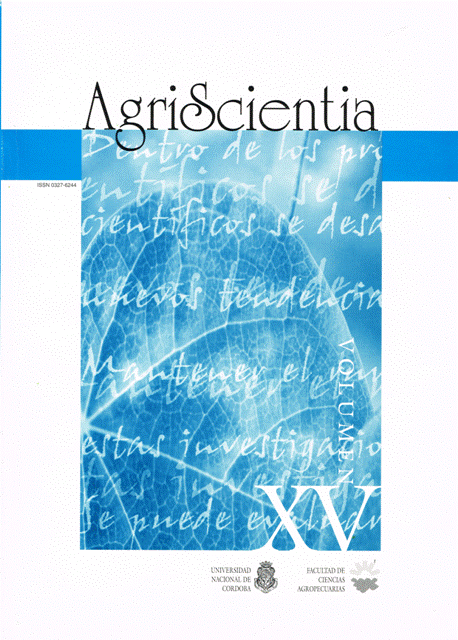Restriction fragment length polymorphism associated with barley starch granule traits
Main Article Content
Abstract
Barley (Hordeum vulgare) starch granule traits were mapped using 123 RFLP markers providing an average marker density of 9.6 cM. QTL-STAT was used to analyze data from 150 F,-derived double haploids from Steptoe x Morex cross, for six starch granule traits. Five significant quantitative trait loci (QTL) (P = 0.001) were found for A granule surface area and volume, proportion of A granules to total starch, and ratio of number of B to A granules. Additional possible QTL effects (P = 0.05) were detected for these four traits plus B granule surface area and volume. Chromosome regions associated with granule surface area coincided with those associated with granule volume. Morex was the source of alleles for increasing A granule surface area and volume, and proportion of A granules to total starch by volume. Steptoe contributed alleles for increasing ratio of number of B to A granules. QTLs for A-granule traits were clustered in three regions on chromosome 2, and one of those chromosomal regions, rbcs-abg2, was associated with all A granule traits. Additional information is desirable on several topics, e.g., role of chromosome 2 in controlling starch granule traits, importance of QTLs with Wald values lower than 10
Article Details
Issue
Section

This work is licensed under a Creative Commons Attribution-ShareAlike 4.0 International License.
How to Cite
References
Armstrong, E., 1992. Identification, distribution and partial characterization of wheat starch-associated proteins. University of Ottawa. (Ph.D. thesis.). 127p.
Bathgate, G.N. and Palmer, G.H., 1972. A reassessment of the chemical structure of barley and wheat granules. Starch 24:374-379.
Becker, J., Vos, P. and Martin, K., 1995. Combined mapping of AFLP and RFLP markers in barley. Mol. Gen. Genet. 249:65-75.
Chen, F. and P.M. Hayes, 1989. A comparison of Hordeum bulbosum-mediated haploid production efficiency in barley using in vitro floret and tiller culture. Theor. Appl. Genet. 77:701-704.
Gebhardt, C. and Salamini, F., 1992. Restriction fragment length polymorphism analysis of plant genomes and its application to plant breeding. Rev. Cytol. 135:201-237.
Hayes, P.M., B.H. Liu, S.J. Knapp, F. Chen, B. Jones, T. Blake, J. Franckowiak, D.C. Rasmusson, M. Sorrels, S. Ullrich, A. Wesenberg, A. Kleinhofs, and R. Nilan, 1993. Quantitative trait locus effects and environmental interaction in a sample of North American barley germplasm. Theor. Appl. Genet. 87:392-401.
Heun, M., 1992. Mapping quantitative powdery mildew resistance of barley using a restriction fragment length polymorphism map. Genome 35:1019-1025.
Holloway, J.L. and S.J. Knapp, 1994. GMendel 3.0 User Guide, Oregon State University, Department of Crop and Soil Science, Corvallis, OR, USA.
Kleinhofs, A., A. Kilian, M.A. Saghai Maroof, R.M. Biyashev, P.M. Hayes, F. Chen, N. Lapitan, A. Fenwick, T.K. Blake, V. Kanzin, E. Ananiev, M. Heun, D. Kudrna, J. Bollinger, S.J. Knapp, B.H. Liu, M. Sorrels, M. Heun, J. Franckowiak, D. Hoffman, R. Skadsen, and B.J. Steffenson, 1993. A molecular, isozyme, and morphological map of the barley (Hordeum vulgare) genome. Theor. Appl. Genet. 86:705-712.
Knapp, S.J. and W.C. Bridges, 1990. Using molecular markers to estimate quantitative trait locus parameters, power and genetic variances for unreplicated and replicated progeny. Genetics 126:769-777.
Laurie, D.A., Pratchett, N., Devos, K.M., Leitch, I.J., and Gale, M.D., 1993. The distribution of RFLP markers on chromosome 2 (2H) of barley in relation to the physical and genetic location of 5S rDNA. Theor. Appl. Genet. 87:177-183.
Macgregor, A.W. and D.L. Ballance, 1980. Hydrolysis of large and small starch granules from normal and waxy barley cultivars by α-amylases from barley malt. Cereal Chem. 57:397-402.
Mansur, L., K.G. Lark, H. Kross, and A.B. Oliveira, 1993. Interval mapping of quantitative trait loci for reproductive, morphological and seed traits of soybean (Glycine max L.). Theor. Appl. Genet. 86:907-913.
Mather, D.E., Tinker, N.A., Laberge, D.E., Edney, M., Jones, B.L., Rossnagel, B.G., Legge, W.G., Briggs, K.G., Irvine, R.B., Falk, D.E., and Kasha, K.J., 1997. Regions of the genome that affect grain and malt quality in a North American two-row barley cross. Crop Sci. 37:544-554.
Oliveira, A.B., D.C. Rasmusson and R.G. Fulcher, 1994. Genetic aspects of starch granule traits in barley. Crop Sci. 34:1176-1180.
Parentoni, S.N., 1993. Mapping quantitative loci for maturity and correlated traits in maize using RFLP markers. M.S. Thesis. University of Minnesota, St. Paul, MN.
Paterson, A., S.D. Tanksley, and M.E. Sorrels, 1991. DNA markers in plant improvement. Advances in Agronomy 46:39-90.
Pierce, J.S., 1991. European Brewery Convention - advances in malting barley. Barley and Malt Committee of the European Brewery Convention. 32 p.
Quarrie, S.A., Laurie, D.A., Zhu, J.H., Lebreton, C., Semikhodskii, A., Steed, A., Witsenboer, H., and Castlestani, C., 1997. QTL analysis to study the association between leaf size and abscisic acid accumulation in droughted rice leaves and comparisons across cereals. Plant Mol. Biol. 35:155-165.
Tinker, N.A., and Mather, D.E., 1995. MQTL: software for simplified composite interval mapping of QTL in multiple environments. Journal of Quantitative Trait Loci 1:2, (http://probe.nalusda.gov:8000/otherdocs/jgtl/1995-02/jgtl6r2.htm).





